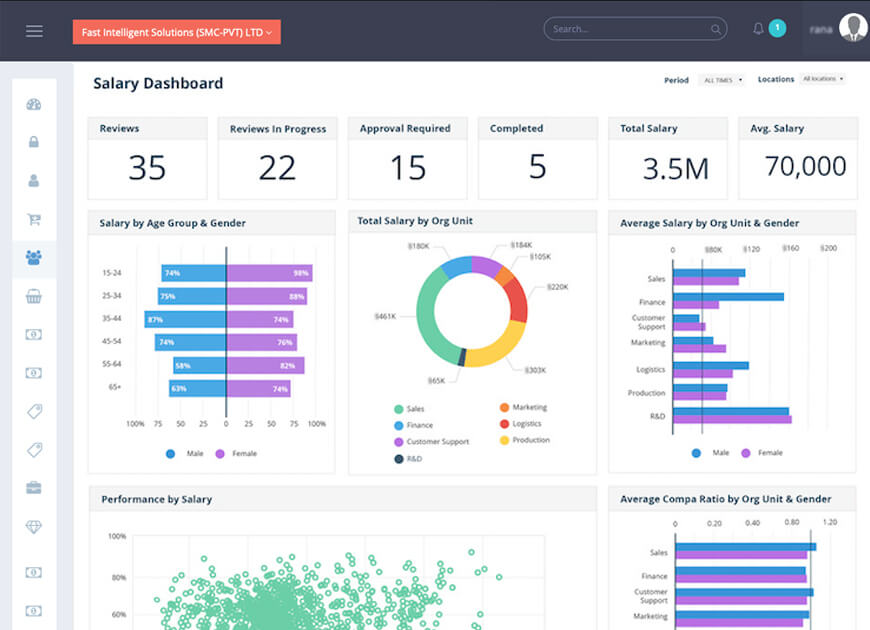Human Resource HR software has revolutionized the way companies manage their workforce. One of the most significant advancements in this field is the implementation of employee self-service (ESS) systems. These systems empower employees to take control of various HR-related tasks, streamlining processes, and enhancing overall efficiency. This article explores how HR software enables employee self-service, the benefits it offers, and the impact it has on both employees and HR professionals.
Understanding Employee Self-Service (ESS)
Employee self-service (ESS) is a feature within HR software that allows employees to handle various HR tasks without the direct involvement of HR personnel. These tasks include updating personal information, accessing pay stubs, requesting time off, enrolling in benefits, and more. ESS systems are typically accessible through a web-based portal or a mobile app, making it convenient for employees to use them from anywhere and at any time.
Key Features of Employee Self-Service
- Personal Information Management ESS allows employees to update their personal information, such as contact details, address, and emergency contacts. This feature reduces the administrative burden on HR staff and ensures that employee records are accurate and up-to-date.
- Payroll and Compensation Employees can view and download their pay stubs, review compensation history, and access tax-related documents. This transparency helps employees understand their earnings and deductions better, reducing payroll-related queries to HR.
- Time and Attendance ESS systems enable employees to clock in and out, request time off, and view their attendance records. This feature streamlines the time-tracking process and allows employees to manage their schedules more effectively.
- Benefits Enrollment and Management Employees can enroll in benefits programs, such as health insurance, retirement plans, and wellness programs, through ESS. They can also make changes to their benefits selections during open enrollment periods or when life events occur.
- Training and Development ESS portals often include access to training and development resources. Employees can enroll in courses, track their progress, and complete required training modules, fostering a culture of continuous learning and growth.
- Performance Management Employees can set goals, track their performance, and participate in performance reviews through ESS. This feature promotes transparency in the performance evaluation process and encourages employees to take ownership of their development.
Benefits of Employee Self-Service
- Increased Efficiency By allowing employees to handle routine HR tasks themselves, ESS systems free up HR professionals to focus on more strategic initiatives. This increased efficiency benefits both the HR department and the organization as a whole.
- Improved Accuracy When employees are responsible for updating their own information, the likelihood of errors decreases. ESS systems often include validation checks to ensure that data entered is accurate and complete.
- Enhanced Employee Engagement ESS empowers employees by giving them control over their own information and HR-related tasks. This empowerment can lead to higher levels of job satisfaction and engagement.
- Cost Savings Automating HR processes through ESS can lead to significant cost savings. Reduced administrative workload means fewer resources are needed to manage HR tasks, leading to lower operational costs.
- Accessibility and Convenience ESS systems are typically accessible online or through mobile apps, making it convenient for employees to access HR services at any time. This accessibility is especially beneficial for remote or geographically dispersed workforces.
- Data Security HR software with ESS capabilities often includes robust security features to protect sensitive employee data. These systems comply with data protection regulations, ensuring that employee information is secure and confidential.
Impact on Employees
- Empowerment and Autonomy ESS systems give employees more control over their HR-related tasks, leading to a sense of empowerment and autonomy. This control can enhance job satisfaction and motivation.
- Real-Time Information Employees have access to real-time information about their employment, compensation, benefits, and performance. This transparency fosters trust between employees and the organization.
- Reduced Dependence on HR With ESS, employees do not need to rely on HR for routine tasks, such as updating personal information or accessing pay stubs. This independence can lead to faster resolution of HR-related issues.
- Improved Work-Life Balance ESS systems often include features for managing time off and scheduling, helping employees balance their work and personal lives more effectively.
- Career Development Access to training and development resources through ESS encourages employees to take charge of their own career growth. This proactive approach to development can lead to better career progression and job satisfaction.
Impact on HR Professionals
- Strategic Focus By automating routine tasks, ESS frees up HR professionals to focus on strategic initiatives, such as talent management, employee engagement, and organizational development.
- Reduced Administrative Burden ESS significantly reduces the administrative workload on HR staff. This reduction allows HR professionals to allocate their time and resources more effectively.
- Data-Driven Decision Making HR software with ESS capabilities often includes analytics and reporting tools. HR professionals can leverage these tools to gain insights into workforce trends and make data-driven decisions.
- Improved Compliance ESS systems help HR professionals ensure compliance with labor laws and regulations. Automated processes reduce the risk of non-compliance and the associated penalties.
- Enhanced Employee Relations With fewer administrative tasks to manage, HR professionals can focus more on building strong relationships with employees. This focus can lead to improved employee relations and a more positive workplace culture.
Challenges and Considerations
While ESS systems offer numerous benefits, there are also challenges and considerations to keep in mind.
- Implementation and Integration Implementing an ESS system requires careful planning and integration with existing HR software. Organizations must ensure that the new system is compatible with their current infrastructure.
- Training and Adoption Employees and HR professionals need training to effectively use the ESS system. Organizations must invest in training programs to ensure smooth adoption.
- Data Security Protecting sensitive employee data is a top priority. Organizations must implement robust security measures to safeguard data and comply with privacy regulations.
- Change Management Transitioning to an ESS system involves change management. Organizations must communicate the benefits and changes to employees to ensure a smooth transition.
- Ongoing Support and Maintenance ESS systems require ongoing support and maintenance to address technical issues and updates. Organizations must allocate resources for continuous support.
Future Trends in Employee Self-Service
The evolution of HR software and ESS systems is ongoing, with several trends shaping the future of employee self-service.
- Artificial Intelligence and Automation The integration of artificial intelligence (AI) and automation in ESS systems will further streamline HR processes. AI can provide personalized recommendations and automate routine tasks, enhancing the employee experience.
- Mobile and Remote Access As remote work becomes more prevalent, ESS systems will continue to evolve to support mobile and remote access. Enhanced mobile apps and cloud-based solutions will ensure that employees can access HR services from anywhere.
- Employee Well-being and Engagement Future ESS systems will place a greater emphasis on employee well-being and engagement. Features such as wellness programs, mental health resources, and engagement surveys will become more integrated into ESS platforms.
- Data Analytics and Insights Advanced analytics and reporting capabilities will enable HR professionals to gain deeper insights into employee behavior and trends. These insights will inform decision-making and drive organizational improvements.
- Personalization and User Experience Personalization will be a key focus in future ESS systems. Tailored user experiences and intuitive interfaces will enhance usability and ensure that employees can easily navigate and utilize the system.
Conclusion
HR software with employee self-service capabilities has transformed the way organizations manage their workforce. By empowering employees to handle HR tasks independently, ESS systems increase efficiency, improve accuracy, and enhance employee engagement. The benefits extend to both employees and HR professionals, leading to a more productive and satisfied workforce. As technology continues to evolve, ESS systems will become even more sophisticated, offering advanced features and capabilities that further enhance the employee experience. Organizations that embrace ESS systems will be well-positioned to thrive in the modern workplace, where efficiency, transparency, and employee empowerment are paramount.




